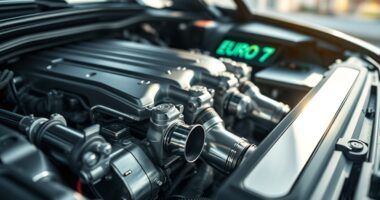In the USA, emissions laws strictly regulate vehicle modifications that disable pollution controls, like catalytic converters or ECU remapping, under the Clean Air Act. Tampering or adding defeat devices is illegal and can lead to hefty fines, vehicle impoundment, or even criminal charges. Enforcement involves roadside checks and advanced detection tech. To stay compliant, use EPA-approved parts and maintain proper documentation. To learn how you can enjoy tuning legally, explore the full details ahead.
Key Takeaways
- Modifying or disabling emissions control devices like catalytic converters is illegal under the Clean Air Act and can lead to penalties.
- EPA and state agencies enforce emissions laws through roadside checks, remote sensing, and smog inspections to detect illegal tampering.
- Using EPA-certified aftermarket parts and ECU maps ensures compliance and avoids penalties for illegal modifications.
- Removing or altering emissions systems can lead to vehicle registration issues, fines, and increased insurance costs.
- Staying informed about CARB EO certifications and performing regular diagnostics helps maintain legal compliance for tuned cars.
Overview of the Clean Air Act and Its Impact on Vehicle Modifications
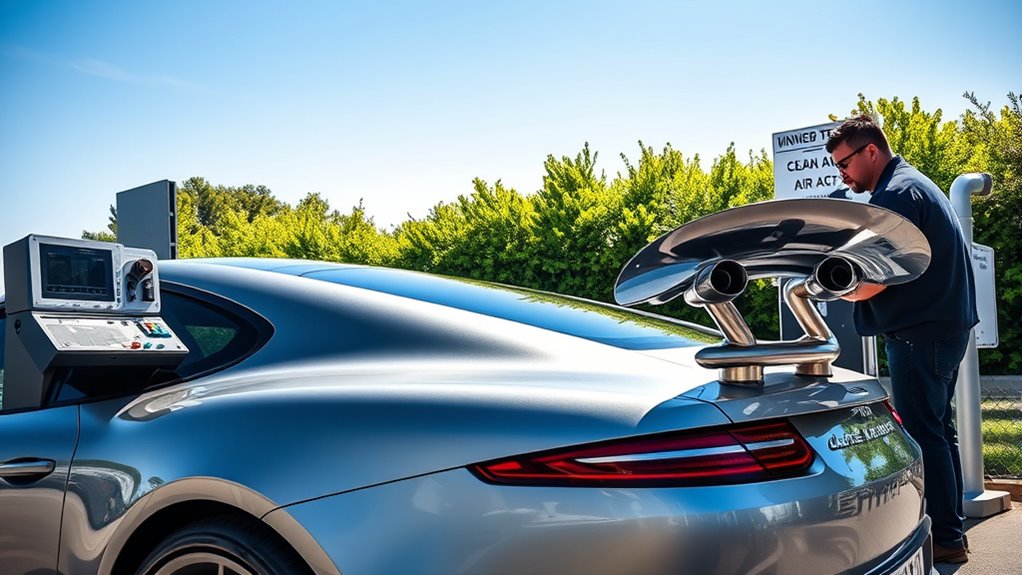
The Clean Air Act (CAA) plays a crucial role in regulating vehicle emissions and shaping how you can modify your car. It targets mobile sources like cars, trucks, and engines to reduce pollutants such as NOₓ, CO, PM, and VOCs. Before new vehicles hit the market, they must meet EPA standards, and it’s illegal to remove or disable emissions control devices like catalytic converters. The law’s framework, established in 1970 and updated periodically, mandates fleet-wide compliance for manufacturers, not just individual vehicles. Prohibited modifications include deleting sensors, reprogramming ECUs, and installing non-compliant aftermarket parts. Violations can lead to hefty penalties, and enforcement involves federal and state agencies working together to ensure adherence to these emissions standards. Understanding emissions laws is essential for anyone involved in vehicle modification or tuning. Additionally, staying informed about emissions testing procedures helps ensure your vehicle remains compliant with all regulations. Maintaining proper emissions control devices is vital for adhering to legal standards and avoiding penalties. A comprehensive understanding of vehicle emissions regulations can help prevent inadvertent violations and support sustainable driving practices.
The Role of the EPA in Regulating Emissions Systems
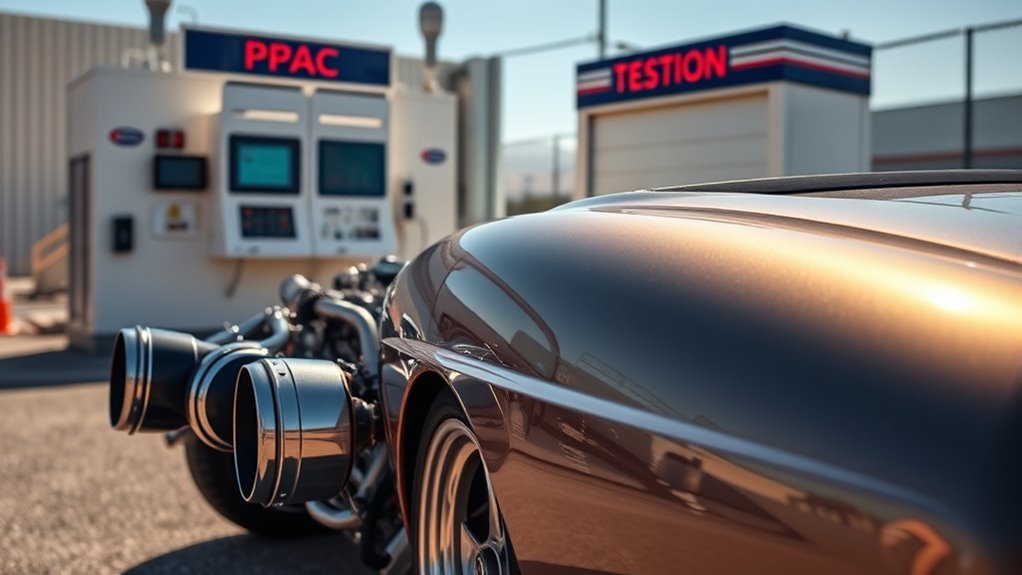
The EPA actively enforces emissions standards for vehicles under the Clean Air Act, aiming to prevent tampering with emissions control systems. Your role in ensuring compliance involves understanding these regulations and avoiding illegal modifications. The EPA targets aftermarket defeat devices that bypass emissions controls, taking legal action against those who manufacture, sell, or install them. Penalties can be severe, including hefty fines and jail time. You should also be aware that:
EPA enforces vehicle emissions standards and targets defeat devices to protect air quality and ensure legal compliance.
- Vehicles must pass smog checks to verify proper emissions.
- Tampering or installing defeat devices can lead to enforcement actions.
- State-specific rules, like California’s, may be stricter.
- Industry players have shifted practices to meet EPA standards.
- Violations can damage reputations and result in costly penalties.
- Staying informed about emissions laws helps you avoid legal trouble and supports cleaner air.
- Compliance with regulations is increasingly important as technology advances and authorities enhance monitoring.
- Understanding emissions testing procedures ensures your vehicle remains compliant during inspections.
- Advances in AI security are enhancing the ability of agencies to detect illegal modifications more effectively.
What Constitutes Tampering and Defeat Devices

Understanding what counts as tampering and defeat devices is essential for staying compliant with emissions laws. Tampering involves modifying or removing emissions control systems, which is illegal under federal law. It can cause harmful emissions to spike, violating the Clean Air Act, and the EPA actively enforces these rules. Defeat devices are systems or software that disable emissions controls during normal operation, increasing pollutants like nitrogen oxides. Installing or manufacturing these devices also leads to penalties. Here’s a quick overview:
| Aspect | Description | Legal Status |
|---|---|---|
| Tampering | Altering emissions controls | Illegal |
| Defeat Devices | Software/hardware disabling controls | Illegal |
| Impact on Emissions | Increased pollutants, violating standards | Illegal |
| Enforcement | EPA monitors and enforces against violations | Active and strict |
Additionally, understanding Self-Understanding can assist in recognizing personal motivations behind modifications, which may influence compliance decisions. Developing a clear awareness of regulatory compliance can help prevent unintentional violations and promote responsible practices. Being aware of potential penalties can also motivate adherence to emissions standards and discourage illegal modifications. Recognizing emissions control systems and their proper maintenance is vital for legal compliance and environmental protection.
Legal Penalties for Unauthorized Modifications
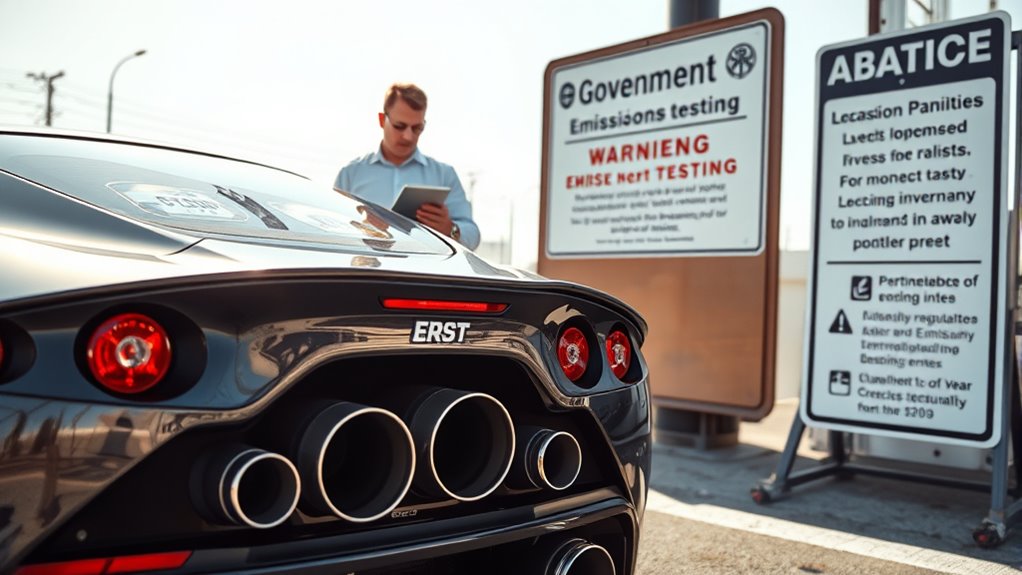
Unauthorized modifications to your vehicle can lead to serious legal consequences, with penalties that vary depending on where you live and the severity of the violation. You might face fines ranging from a few hundred to thousands of dollars, or your vehicle could be impounded until you fix the issue. In severe cases, criminal charges may apply if your modifications cause emissions or safety violations. Your insurance could be affected, leading to higher premiums or coverage denial, and you might be held more liable if you cause an accident.
- Pay hefty fines or face vehicle impoundment
- Encounter criminal charges for serious violations
- See increased insurance costs or coverage loss
- Deal with registration issues or reduced resale value
- Face legal liability if involved in an accident
How Emissions Standards Are Set for Different Vehicle Types
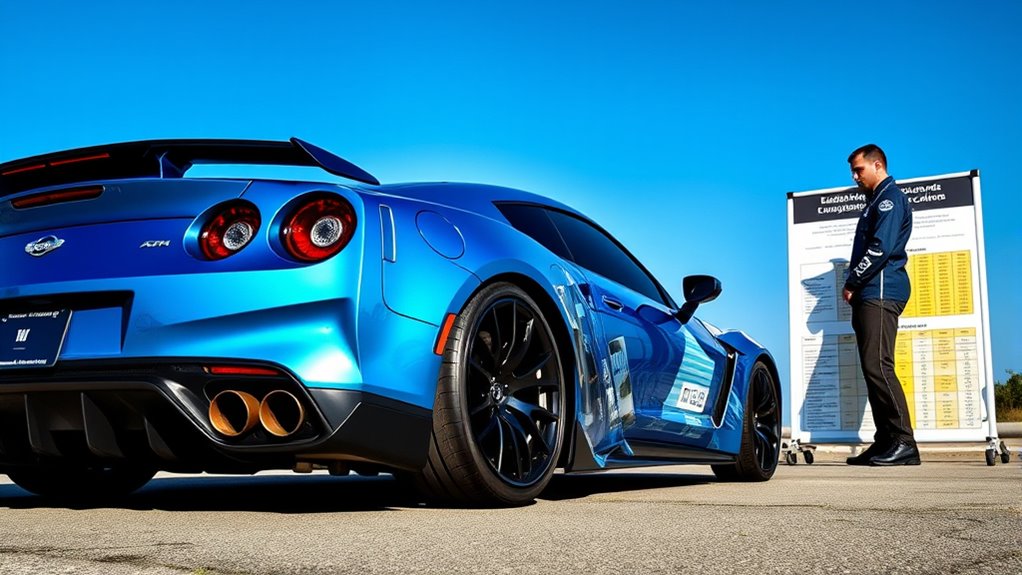
Different vehicle types are subject to distinct emissions standards tailored to their size, usage, and environmental impact. Light-duty vehicles, like cars and SUVs, follow Tier 3 standards phased in between 2017 and 2025, measuring pollutants such as NOx, CO, PM, and NMOG. Medium-duty vehicles, including large vans and SUVs, also fall under Tier 3, but trucks between 10,001 and 14,000 lbs GVWR have separate regulations. Heavy-duty trucks and buses—over 26,001 lbs GVWR—must meet increasingly stringent standards, with regulations finalized for 2027-2032. Motorcycles are regulated separately with specific limits. The EPA employs different test cycles, like FTP-75 for light-duty and SET/FTP for heavy-duty, to assess compliance. Emission components include criteria pollutants, toxics, greenhouse gases, and evaporative emissions, all with durability and certification requirements. Emission standards are designed to reflect real-world driving conditions and ensure that vehicles achieve compliance throughout their operational life. Additionally, advancements in testing procedures aim to improve the accuracy and relevance of emissions assessments under various driving environments. Implementing innovative repair solutions can also help vehicle owners maintain compliance more effectively and extend vehicle longevity.
California’s Stricter Standards and Their Nationwide Influence
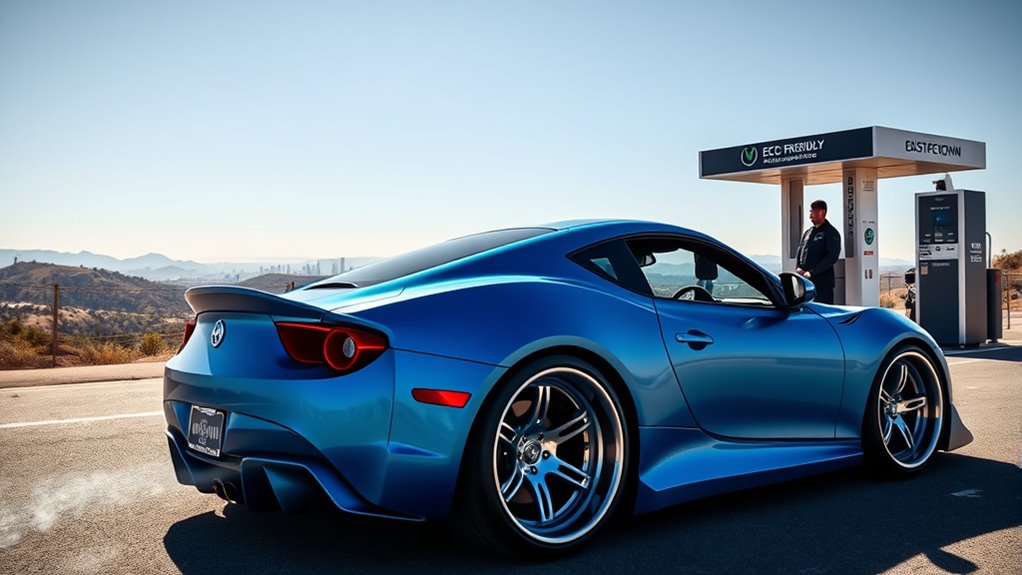
California’s stricter emissions standards have considerably influenced nationwide vehicle regulations and aftermarket practices. These rules lead 17 states to adopt CA’s standards under the CAA Section 209(b) waiver, shaping industry norms. You’ll find that aftermarket manufacturers seek CARB EOs to stay marketable across the country. The focus on ECU tampering aligns federal EPA actions with California’s crackdown, especially on illegal ECU modifications. Additionally, California’s push for a 2035 ICE ban puts pressure on automakers nationwide to prioritize electric vehicles. This influence extends to:
- Requiring CARB EO certification for aftermarket parts
- Harmonizing EPA and California emissions rules
- Increasing demand for CARB-compliant tunes and modifications
- Federal crackdowns on diesel ECU tampering
- Accelerating the shift toward electric vehicle adoption nationwide
- Emission standards enforcement has become a central focus in regulating vehicle modifications and ensuring compliance. Moreover, compliance strategies employed by manufacturers are evolving to meet these increasingly stringent standards and avoid penalties. Industry stakeholders are also investing in advanced testing methods to demonstrate compliance more efficiently. This influence extends further into the aftermarket industry, compelling manufacturers to adhere to strict standards to maintain legality and marketability. The ongoing industry adaptation highlights the importance of staying informed about evolving regulations to ensure compliance.
Compliance Strategies for Vehicle Manufacturers and Owners
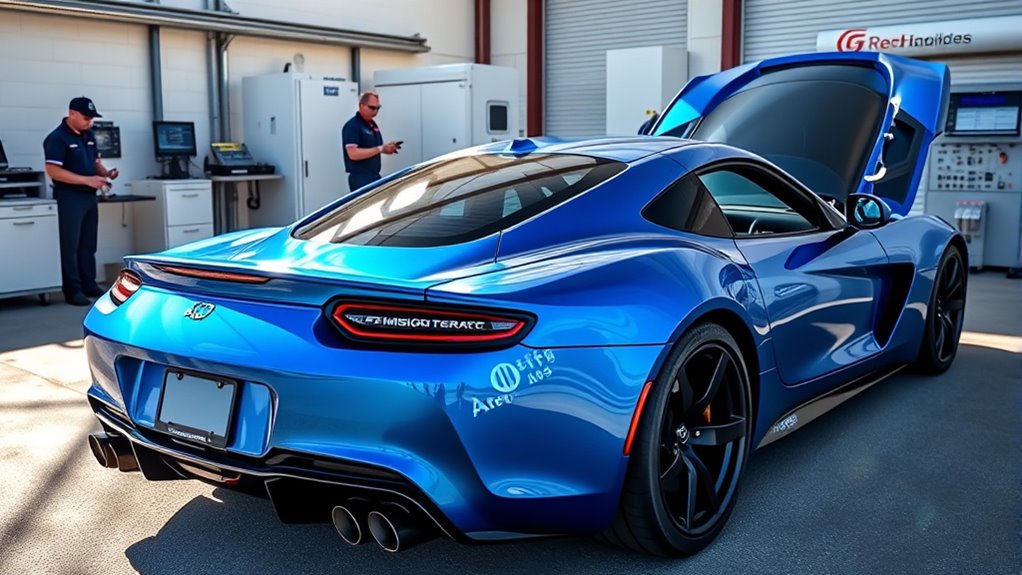
Manufacturers and vehicle owners must adopt clear compliance strategies to navigate the complex landscape of emissions laws. For manufacturers, this means offering EPA-approved performance parts that keep emissions intact, developing ECU maps for certified upgrades, and partnering with OEMs to provide factory-backed tuning options. They also need to verify aftermarket parts like high-flow catalytic converters meet EPA/CARB standards, and use parts with proper EO numbers. Owners should stick to certified modifications, avoid illegal tampering, and use certified repair shops for emissions-related work. Regular smog checks, retaining documentation, and performing periodic OBD-II scans help prevent violations. For vehicles modified for racing, keeping documentation of non-road use is essential. Staying informed and working within legal frameworks ensures compliance and avoids costly penalties.
Detection Methods and Enforcement of Emissions Laws

Detection methods and enforcement strategies have become increasingly sophisticated to guarantee compliance with emissions laws. You might encounter on-road remote sensing technologies that measure pollutants like CO, NOx, and hydrocarbons without touching your vehicle. These include infrared/UV spectroscopy and laser-based EDAR systems, which can also capture license plates and speed. Speed and acceleration tracking verify emissions under real driving conditions, especially in high-traffic areas. To ensure accuracy, authorities use multi-lane deployment and pilot programs proven effective in the US and UK.
- Infrared/UV spectroscopy for real-time analysis
- Laser EDAR systems for detailed pollutant and license plate data
- Speed tracking during roadside checks
- Multi-lane high-volume testing
- Enforcement via CARB EO and RTD tracking
Technological Innovations in Emissions Control

Technological innovations are transforming emissions control by enhancing efficiency and reducing pollutants across various industries. You now benefit from advanced systems like TWC, SCR, and diesel oxidation catalysts that optimize catalytic efficiency and lower emissions. Electrification of industrial controls replaces fossil fuels, cutting greenhouse gases and operational costs, while improving precision with electrified thermal management. AI-driven sensors enable real-time monitoring, predictive maintenance, and automated compliance, ensuring your vehicle or facility stays within legal limits. Additionally, bio-based filtration technologies utilize biodegradable materials, reducing chemical waste and promoting sustainability.
| Innovation Type | Key Benefit |
|---|---|
| Advanced Catalyst Systems | Reduce NOx, CO, and hydrocarbons efficiently |
| Electrification of Controls | Lower emissions and operational costs |
| AI-Driven Monitoring | Real-time alerts and predictive diagnostics |
| Bio-Based Filtration | Eco-friendly particulate and VOC removal |
Environmental and Public Health Benefits of Strict Emissions Enforcement
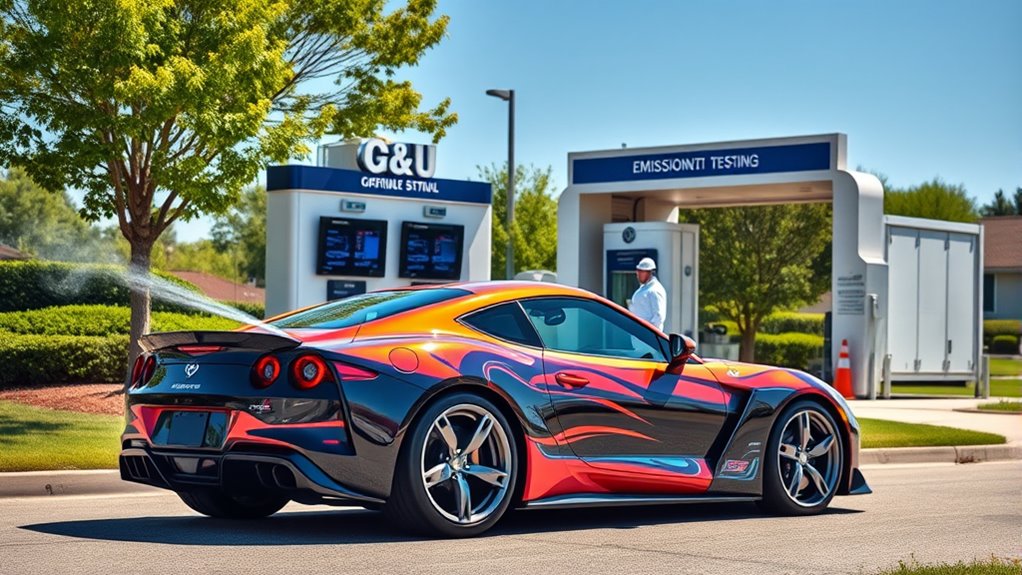
Enforcing strict emissions laws delivers significant environmental and public health benefits by reducing pollutants that harm ecosystems and human well-being. Cleaner air means less damage to plants, forests, and water bodies, protecting aquatic life and soil quality. It also improves crop yields, supporting agriculture. On the health front, reduced pollution lowers premature deaths, eases respiratory issues, and boosts overall well-being. You’ll also see economic benefits, like lower healthcare costs and increased productivity. Plus, strong enforcement deters violations, ensuring consistent emissions reductions.
- Better air quality protects ecosystems and water sources
- Fewer health issues lead to less healthcare spending
- Agriculture benefits from cleaner air and water
- Enforcement encourages industries to comply
- Reduced emissions help fight climate change
Frequently Asked Questions
Can I Legally Modify My Car’S Exhaust System for Better Performance?
You can modify your car’s exhaust system for better performance, but you need to follow your state’s laws. Check local regulations, especially noise and emissions standards, because some states like California and Texas have strict rules. Make sure your modifications won’t void your warranty or lead to legal penalties. Proper installation and maintenance are key to ensuring your upgraded exhaust is both legal and safe, avoiding costly fines or vehicle issues.
Are There Any Legal Aftermarket Parts That Do Not Violate Emissions Laws?
You’re wondering if any aftermarket parts stay within emissions laws. Certain OEM-matching replacement parts, like catalytic converters, oxygen sensors, and spark plugs, are legal if they meet OEM or CARB standards. Cosmetic upgrades or parts that don’t affect emissions systems are generally permitted. Always keep documentation proving compliance, and check local regulations before installation. This way, you can improve your car’s performance without risking legal issues.
How Can I Tell if a Tuning Device Is Considered a Defeat Device?
You can tell if a tuning device is a defeat device if it’s designed to bypass or disable emissions controls, especially under normal driving conditions. Look for software that increases emissions or disables components like catalysts or EGR systems. If the device’s purpose is to improve performance at the expense of emissions compliance, it’s likely considered a defeat device and illegal. Always check manufacturer claims and verify the device complies with EPA regulations.
Do Electric Vehicles Face the Same Emissions Regulations as Combustion Engines?
You might think electric vehicles (EVs) face the same emissions rules as combustion engines, but that’s not entirely true. EVs produce zero tailpipe emissions, so they’re not directly regulated the same way. However, their environmental impact depends on how the electricity is generated. Regulations encourage EV adoption, and incentives support cleaner energy. While rules differ, the overall goal is to reduce pollution from all vehicle types.
What Are the Specific Penalties for Manufacturing or Selling Tampering Devices?
You should know that manufacturing or selling tampering devices can lead to serious penalties. If you produce defeat devices, you risk civil fines up to $4,819 per device, and criminal charges are possible if you’re involved with counterfeit products. Selling tampering devices can result in fines exceeding $5,000 per unit. These actions also carry the risk of criminal prosecution, environmental harm, and damage to your reputation.
Conclusion
So, while you might think tuning your car is just about performance, the law reminds you it’s also about clean air and public health. Ironically, pushing for more power could land you hefty fines or even car confiscation. Staying compliant isn’t just legal—it’s smarter. After all, the real upgrade is knowing you’re doing your part. Because, in the end, a cleaner planet beats a louder exhaust, right?



